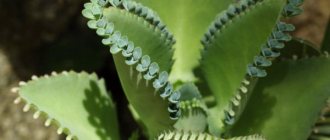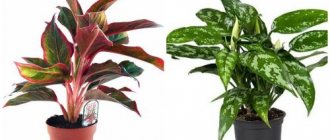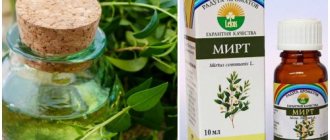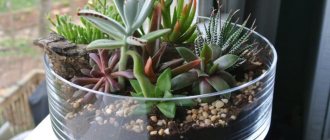Calathea crocata. Photo Calathea belongs to the Marantaceae family. The homeland of calathea is South America, where it grows in tropical rainforests. The plant is hidden from the scorching sun by the spreading branches of tall trees.
Calathea got its name from the word “calathos”, which translates from the Greek “basket” - its leaves were used in ancient times for weaving.
It is a herbaceous perennial plant with many varieties, tuberous and rhizomatous. The leaves grow on elongated petioles and are usually pink or purple on the underside. Blooms from early spring to mid-summer, depending on the species. If the conditions are suitable for her, the flowering period lasts up to 2-3 weeks. The inflorescences are inconspicuous: small flowers are compactly collected in spike-shaped inflorescences. Their color is varied.
| The growth rate is low, up to 7 new leaves per year. |
| Blooms from early spring to mid-summer, depending on the species. |
| The plant is grown with difficulty. |
| It is a perennial plant. |
Caring for calathea at home. Briefly
Calathea at home requires special attention; if care requirements are not followed, problems will arise and the plant may die:
| Temperature | 16-24°C in summer, about 16°C in winter, at least up to 10°C. Avoid temperature changes. |
| Air humidity | From 60%. Maintained by regular spraying - at least 3 times a week. Do not wet varieties with terry leaves, but humidify the air next to them. |
| Lighting | Moderate, keep away from direct sunlight. The optimal location is 2 meters from the window in a western direction. |
| Watering | In summer - 2-3 times a week, in winter once is enough. Do not allow water to stagnate in the pot. The water is soft and warm. |
| Priming | With the addition of sand or peat, breathable. When preparing it yourself, mix: leaf soil - 2 parts, peat - 1, sand - 1. |
| Feeding and fertilizer | During the growing season, a liquid preparation diluted 1:2 is required every 10-15 days. An excess of calcium and nitrogen is unacceptable. |
| Transfer | For young plants - every year in February or March. Next - after 2-4 years, when the pot becomes too small for the root system. |
| Reproduction | By dividing the bush when replanting, so that each plant has several leaves and 2-3 full roots. When propagated by seeds, they need to be germinated at 20-24°C. |
| Features of cultivation | In summer, the plant can be taken out into the open air - into the garden, onto the balcony, but protected from drafts. Loves the humidity of the bathroom. The leaves are folded at night. They are easy to damage, wipe with care. |
Kalateya Varshevich.
Photo For successful cultivation, you should study the care rules in more detail.
Photo gallery
In the warm season, calathea feels comfortable at an air temperature of +20–25 °C, in winter not lower than +16–18 °C. In conditions of high humidity, the maximum permissible is +30–35 °C. The lower limit that a flower can survive is +16 °C, after which the roots will begin to rot.
The daylight hours of this plant should last 10–14 hours, so in the cold season you need to use additional lighting. If there is insufficient lighting, the flower stops growing and sheds its leaves.
Calathea needs high air humidity - at least 60%, and preferably 90–95%. Therefore, the air near the flower needs to be sprayed frequently, especially in winter. You can also increase the humidity level by placing a container of water next to the flower.
During the flowering period, you need to feed the calathea with fertilizer for flowering plants, such as Agricola, once every 14 days. Afterwards, the faded flowers should be trimmed, leaving 5 cm and removed completely when they dry out.
Caring for calathea at home. Details
Indoor calathea is not the most capricious plant, but it is not unpretentious either.
If the temperature, humidity, or light levels deviate from its normal level, the calathea may get sick and die. Some varieties are hardier and cope better with indoor conditions than others, such as Makoya. The main problem with growing in apartments is dry air during the cold season due to radiators and heaters. Its leaves have a large area from which evaporation constantly occurs. In tropical forests, losses are compensated by moist air, but in a dry room the process is too intense. The root system does not have time to replenish reserves, which is why the leaves begin to dry out.
Such features require a more attentive attitude to the plant and compliance with care requirements.
Calathea flowering
Calatheas produce small flowers of various shades - they depend on the type of plant.
Makoya, wonderful and mosaic calathea have white, tubular-shaped inflorescences released from the base of the leaves. Saffron calathea is notable for its bright orange flowers, and zebrina has lilac flowers. To increase the flowering period, flower growers use one trick. Usually such measures bring good results in the case of saffron calathea. It blooms for 2-3 months. When its shoots have grown by more than 15 cm, in mid-August the pot is moved to a darker place for 10 weeks.
Watering is reduced to a minimum. At this time, the flower will create new buds. Upon returning to the previous bright place, resume regular watering. After another 2 months, the calathea will bloom.
Temperature
Calathea at home loves warmth and does not tolerate drafts and temperature changes. In summer, the normal temperature for it is considered to be 22…24°C. In winter, it is optimal to maintain 16…18°C.
If the temperature is above 20 degrees, then it is necessary to provide the flower with additional air humidification.
Spraying
Spraying is useful for calathea, and even a warm shower will benefit the plant. But this only applies to varieties with smooth leaves. Terry representatives should be protected from contact with water drops on the surface. In this case, the best option is to humidify the air around the plant.
Lighting
The calathea flower at home does not tolerate the sun; direct exposure to the rays can be destructive for it.
The leaves react painfully - they curl up, their color changes and becomes paler. Burns will be visible on the surface. When choosing a place for a pot, preference should be given to a western or eastern window, but not on the windowsill, but a couple of meters from it.
The room should be light enough. If you place the plant in a dark corner, it will need additional lighting from artificial sources for at least 12-14 hours a day.
The fluorescent lamp should be installed at a distance of 20 cm from the leaves.
Watering
You should be extremely careful about watering. Homemade calathea does not tolerate either overdrying or excessive moisture or stagnation of water in a pot or tray.
Fleshy leaves absorb water in large quantities, so a lack of moisture poses a threat to the health of the plant. If there is an excess, there is a growth arrest and a depressed state. The leaves become covered with spots, which indicates the beginning of rotting of the root system.
To avoid problems with watering, you should choose a light soil substrate for the flower. It should resemble the soil of the calathea's natural habitat. They grow on loose, light soils that do not retain water. For a plant, stagnation of moisture is much more dangerous than its lack. They are prepared for drought - the root system has tuberous processes that satisfy the need for water if necessary.
There is no need to water the plant until the soil in the pot dries out after previous moistening.
Calathea pot
The pot should be chosen to be small, since calathea has a superficial root system. Because of this, the excess volume of soil risks turning sour. A low and wide option would be ideal. It is better if it is clay - in such a container there is less risk of water stagnation.
If the roots of an adult plant appear through the drainage hole, then the pot is small and the plant needs to be replanted.
Soil for calathea
The soil should be light, loose, water- and breathable. The easiest way to prepare your own substrate is this recipe: leaf soil, peat and sand in a ratio of 2:2:1. Additives such as sphagnum, crushed pine bark, coco soil, and pieces of charcoal enrich the mineral composition of the soil. Store-bought soil may not be suitable for calathea; coarse sand must be added to it to loosen it.
Feeding and fertilizer
For calathea, home care should be accompanied by periodic improvement of soil quality. Organic fertilizers are beneficial, but an excess of salts can be detrimental to the flower. Fertilizing is carried out with liquid products in half the dose recommended by the manufacturer.
The frequency of procedures is once every 2 weeks.
Calathea transplant
Frequent transplants are harmful to the plant and can be difficult to tolerate.
The young flower must be transferred annually to a new pot, more suitable in size for the grown root system. When replanting, you should not remove the soil from the roots to avoid damaging them, but place them in a new container with a lump of earth. Be sure to equip the pot with a drainage layer to remove moisture. An adult plant is replanted every 2-4 years , depending on the intensity of growth.
Trimming
Calathea leaves are cut off if they are completely dry. When transplanting a plant and propagating by division, all dry and diseased parts of the plant are removed from the bushes.
Is it possible to leave Calathea without care during the holidays?
Long-term lack of care can cause irreparable damage to the health of the plant, resulting in its death. Calathea cannot be watered “in reserve” - excessive moisture will lead to rotting of the roots. Lack of moisture is also harmful to the flower. If the absence of hosts lasts 3-5 days, the plant will cope. But a longer stay without care is unacceptable.
Description of the plant
Calathea is an evergreen perennial plant belonging to the Marantaceae family. About 300 species of the genus Calathea are known, occurring naturally in South and Central America and the Caribbean. In our climatic conditions, calatheas are grown as ornamental indoor plants.
The name of the genus Calathea is due to the fact that baskets were previously woven from the leaves. In ancient Greek, the word Kalathos means "basket".
This is interesting. In English, the plant is called prayer plant or “prayer plant” because of its special adaptation to the rhythm of day and night. At dusk, the leaves fold vertically, like hands in prayer.
The main decoration of calathea is large leaves on the underside that are purple, and on top - green, white, pink, purple or brownish. Their additional decoration is stripes and patterns, giving each plant an original character. They look as if each leaf was individually painted with original patterns.
These perennials inhabit the low, dark layer of the tropical forest. To “catch” as much light as possible, the plant directs its leaves towards the sun. The petioles have articular cushions, thanks to which they move in response to light.
During the day they change position:
- at midday, when there is a lot of light, the leaf blades are parallel to the ground to consistently follow the light;
- in the evening - perpendicular to the light;
- at night - they take a vertical position, look like hands folded in prayer;
- at dawn they begin to unfold again.
Sometimes during the day the leaves may curl if the sun is too hot. They have the ability to fold along the main vein, which protects them from sunburn and excessive moisture loss. Regardless of the amount of light, the plant's biological clock also controls nighttime movement.
If a plant has a lot of leaves, they rub against each other when moving behind the sun, making a characteristic rustling sound.
Advice. If you want to capture the movement of leaves on film, find the time-lapse mode in your camera settings. Place the camera still and turn it on. The recording should take about an hour, but the video itself in this version will take up to 30 seconds. In accelerated viewing you can see what the phenomenon of the plant lifting its leaves looks like. Just like in National Geographic nature films.
Two other species of the family Marantha, related to “praying” plants, are also cultivated as indoors: arrowroot (Marantha) and stromantha (Stromanthe). Their foliage has a shape and pattern similar to that of the Calathea, but older specimens produce longer shoots and inflorescences with a different structure. There is no need to confuse them.
The plant can grow up to 0.5 m wide and 0.5 m high (the largest specimens reach a height of 1 meter). During the growing season, calathea can produce 5-6 new leaves.
Calathea flowers have different colors and shapes depending on the type and variety.
According to scientific research from NASA, some plants are more effective than other types in improving indoor air quality. Calathea has the ability to cleanse the air of toxins and harmful substances. This indoor plant will ensure that harmful gases are neutralized by absorbing and decomposing them. Plants improve indoor air humidity and occupant health by efficiently converting carbon dioxide (CO2) into oxygen.
Calathea propagation
The plant can be propagated in three ways: division, cuttings and seeds.
Reproduction of calathea by dividing the bush
Most often, calathea is propagated by dividing the bush - this is the most effective way, which allows the seedling to quickly adapt and begin to grow. Only healthy and large plants are suitable for division.
The bush is disassembled by hand so that each part has 2-3 leaves and several high-quality roots. Divisions that are too small take root very poorly and may die.
The seedling is immersed in light soil of peat and sand, the upper part is covered with a plastic bag, maintaining high humidity underneath. When growth and the appearance of new leaves are noticeable, the plant is transferred to normal conditions.
Propagation of calathea by cuttings
Propagation by cuttings is available for calathea. In this case, a stem with a length of 15 cm is selected. It should have a growing point and 3-4 leaves. The stem is planted in a substrate of peat and sand.
The pot is left in a warm and very humid place until the cuttings take root.
Growing calathea from seeds
Not the most popular way to propagate calathea is through seeds. They are laid on the soil surface for several weeks, slightly pressed down on top, and covered with glass on top to create a greenhouse effect. After germination, they should be sprinkled with 1 cm of soil.
When sprouts appear, you need to start airing: remove the glass for 30 minutes. If the plants have reached 2-3 cm in length, then it’s time to replant them in separate pots and care for them as usual.
What kind of soil is needed?
The soil for calathea should be moisture-permeable, nutritious, have good aeration and weak (pH 5.0–6.0) or neutral (pH 6.0–7.0) acidity.
You can use ready-made soil for arrowroot or azaleas, or prepare it yourself by mixing in equal parts:
- high peat;
- leaf soil;
- humus;
- coarse sand.
To deoxidize the resulting substrate, you need to add crushed charcoal to it at the rate of 40 grams per 1 kg of soil mixture.
The soil should not contain lime.
To get rid of pests, the soil mixture must be steamed in a water bath, poured with a weak solution of manganese, calcined in the oven, or treated with insecticides and fungicides, such as Aktara, Aktellik or Fundazol.
Diseases and pests
Calathea leaves turn yellow.
Photo Calathea can get sick, and to save the plant, you need to know the signs and causes of their occurrence:
- the tips of the leaves turn brown - the air is too dry;
- the calathea leaves have drooped and wrinkled - the air is too dry;
- Calathea leaves dry out - dry air during the heating season;
- calathea leaves curl - excessive lighting;
- white-yellow spots appear on the leaves - excessive lighting;
- leaves become covered with dark spots - excessive soil moisture;
- leaf petioles are strongly elongated - insufficient lighting;
- brown spots on calathea – sunburn;
- brown dry edges of leaves - irregular watering, hard water, dry air;
- Calathea leaves have become lethargic - cold air or temperature changes.
The cause of the deterioration of the calathea can be pests. It is susceptible to attack by spider mites - its most dangerous enemy, as well as mealybugs, scale insects and whiteflies.
How to care for autumn and winter?
With the onset of cold weather, the calathea prepares for sleep. Its metabolic process is significantly reduced, so the amount of fertilizer applied is reduced. But Calathea Saffron, which begins to bloom during this period, must continue to be fed according to the usual scheme.
The liquid content in the pot in the autumn-winter period is also important. Water the flower only when the soil is one third dry. If the room temperature is not high, watering is done when the soil is half dry. It must be remembered that a tropical plant does not require a strong drop in temperature for wintering, otherwise it will freeze.
Types of homemade calathea with photos and names
Here are the most popular representatives of Calathea. They adapt to life in a city apartment more easily than others.
Calathea saffron, crocata
It has dark green leaves, violet-purple on the underside. Bright orange flowers are produced on long petioles.
Calathea painted
The oval leaves are up to 20 cm in length, in the center they have a symmetrical color of light and dark green stripes, framed along the edges with a white or pink pattern.
Makoya
A lush bush with painted leaves - the light green surface is decorated with dark ovals and thin lines. The lower part is burgundy. Blooms with purple inflorescences.
Calathea striped
Straight vertical stems grow up to 40-60 cm. Large oblong leaves also reach 40 cm. Their color is dark green, with light stripes over the entire surface.
Calathea leopardis
Elongated leaves with a pointed tip. Light green with dark stripes. Plant up to 50 cm high.
Transfer
Due to the specific toxins released into the soil by the roots of the plant and leading to its death, replanting is a necessary procedure for calathea. It is better to carry it out in early spring.
Reasons for transplant:
- disease;
- growth of the root system;
- 14 days have passed since the purchase.
Before the calathea reaches 3 years, it needs to be replanted annually, then every 2-3 years.
Transplant instructions:
- water the plant generously 1.5 hours before transplanting;
- Place a drainage layer a quarter of the height of the container on the bottom of the flowerpot, sprinkle it with crushed charcoal or activated carbon to prevent root rotting;
- pour a layer of soil on top not exceeding 2–3 cm;
- carefully remove the calathea from the old container along with a lump of earth;
- rinse the roots in cool water;
- cut all damaged roots with a sharp knife strictly perpendicularly, remove old and dry leaves;
- treat the cut areas with crushed activated carbon or wood ash;
- place the plant in a new pot and soil, carefully straighten the roots;
- make sure that the growing point is strictly in the center of the flowerpot and above the soil surface;
- carefully pour the soil into the pot, leaving 1.5–2 cm to its upper edge;
- lightly press, but do not compact the soil.
After replanting, it is necessary to water the calathea generously and put it away for 2-3 days in a cool place where direct sunlight does not penetrate. The next watering is carried out after 8–10 days.
General information
Calathea is one of the representatives of the Marantaceae family. The plant's homeland is considered to be South and Central America, although it is found in almost all tropical zones.
The Calathea genus is extensive and includes many decorative deciduous herbaceous or liana-like perennials. The leaves of most of them are oblong-oval or lanceolate, collected in rosettes. Their distinctive feature is a pattern of geometrically regular, symmetrical spots. The lower part is most often colored purple and sometimes has pubescence. Like related arrowroots, the leaves of some species may fold and droop after dark. For this feature they are called prayer flowers.
The size of the bushes can reach 1.5 m, but indoor varieties are more compact. The shoots are mostly underground, less often short vertical. Some varieties form only one true leaf per rosette; others “release” 5-6. The leaves quickly evaporate moisture, so in arid climates the plant dies. With the exception of two species, calatheas do not bloom. After flowering, the above-ground part may die off.
Conclusion
An amazingly beautiful flower, as if endowed with magical qualities, is Calathea, a well-known flower among domestic gardeners. True, despite its exotic, inimitable beauty, which can elevate absolutely any flower garden to a new level, the plant has become famous as incredibly sensitive to care. Even not all experienced flower growers really cope with it.
Of course, we recommend not to overestimate your strengths, but to carefully prepare for choosing a variety, and then caring for Calathea. And you have already taken the first step towards this by reading our article.
For our part, we wish you good luck, because a well-groomed and fragrant Calathea in your greenhouse will certainly become a kind of order, evidence of your professional success in floriculture!
The main problems when growing a flower
Flower growers have long noticed that if you do not follow the recommendations for growing this capricious plant, you can encounter many problems. Most often, the leaves of the flower begin to dry out and curl up. Reasons for this condition:
- too dry room;
- the room temperature is low;
- presence of drafts.
The cause of flower diseases must be eliminated in advance, then the plant will be grateful to you, returning its former beauty.
Calathea turns yellow
When the lower leaves begin to lose color, this is natural: some leaves die, others are born. When the leaves turn yellow throughout the plant, you need to sound the alarm. The reason may be:
- improper watering,
- high concentration of fertilizers,
- cold in the room.
Calathea leaves curl when the air in the room is too dry or cool.
Pests and diseases
Damaged calathea leaves can become infected with sooty fungus, which is a black film. It does not harm the plant, but prevents it from breathing freely. You can remove the fungus with a simple soap solution.
Among the flower pests we can note:
- scale insect,
- spider mite,
- thrips.
First, you can try to fight them with a soap solution. If this method does not help, then the flower needs to be treated with insecticides. Insecticides are used to kill spider mites.
Watch the video! Calathea. Home care
Pink-colored roseopicta or medallion
It is distinguished by unusual leaves: on the reverse side they are reddish, and the upper part of the plate has circular patterns consisting of various shades of green .
Calathea is a plant that is valued not only for its unique leaves and flowers, but also has a beneficial effect on people on a mental level. This beauty is capable of absorbing the energy of aggression , bringing peace not only to the family, but also to the work team.
It symbolizes family happiness and home comfort. In addition to indoor floriculture, calathea varieties are used in floristry , since their stems remain fresh in water for a long time.











